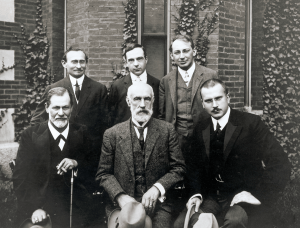Steve Ayan in Scientific American:
 In 1909 five men converged on Clark University in Massachusetts to conquer the New World with an idea. At the head of this little troupe was psychoanalyst Sigmund Freud. Ten years earlier Freud had introduced a new treatment for what was called “hysteria” in his book The Interpretation of Dreams. This work also introduced a scandalous view of the human psyche: underneath the surface of consciousness roils a largely inaccessible cauldron of deeply rooted drives, especially of sexual energy (the libido). These drives, held in check by socially inculcated morality, vent themselves in slips of the tongue, dreams and neuroses. The slips in turn provide evidence of the unconscious mind. At the invitation of psychologist G. Stanley Hall, Freud delivered five lectures at Clark. In the audience was philosopher William James, who had traveled from Harvard University to meet Freud. It is said that, as James departed, he told Freud, “The future of psychology belongs to your work.” And he was right.
In 1909 five men converged on Clark University in Massachusetts to conquer the New World with an idea. At the head of this little troupe was psychoanalyst Sigmund Freud. Ten years earlier Freud had introduced a new treatment for what was called “hysteria” in his book The Interpretation of Dreams. This work also introduced a scandalous view of the human psyche: underneath the surface of consciousness roils a largely inaccessible cauldron of deeply rooted drives, especially of sexual energy (the libido). These drives, held in check by socially inculcated morality, vent themselves in slips of the tongue, dreams and neuroses. The slips in turn provide evidence of the unconscious mind. At the invitation of psychologist G. Stanley Hall, Freud delivered five lectures at Clark. In the audience was philosopher William James, who had traveled from Harvard University to meet Freud. It is said that, as James departed, he told Freud, “The future of psychology belongs to your work.” And he was right.
The view that human beings are driven by dark emotional forces over which they have little or no control remains widespread. In this conception, the urgings of the conscious mind constantly battle the secret desires of the unconscious. Just how rooted the idea of a dark unconscious has become in popular culture can be seen in the 2015 Pixar film Inside Out. Here the unconscious mind of a girl named Riley is filled with troublemakers and fears and housed in a closed space. People like to think of the unconscious as a place where we can shove uncomfortable thoughts and impulses because we want to believe that conscious thought directs our actions; if it did not, we would seemingly have no control over our lives.
This image could hardly be less accurate, however. Recent research indicates that conscious and the unconscious processes do not usually operate in opposition. They are not competitors wrestling for hegemony over our psyche. They are not even separate spheres, as Freud’s later classification into the ego, id and superego would suggest. Rather there is only one mind in which conscious and unconscious strands are interwoven. In fact, even our most reasonable thoughts and actions mainly result from automatic, unconscious processes.
More here.
